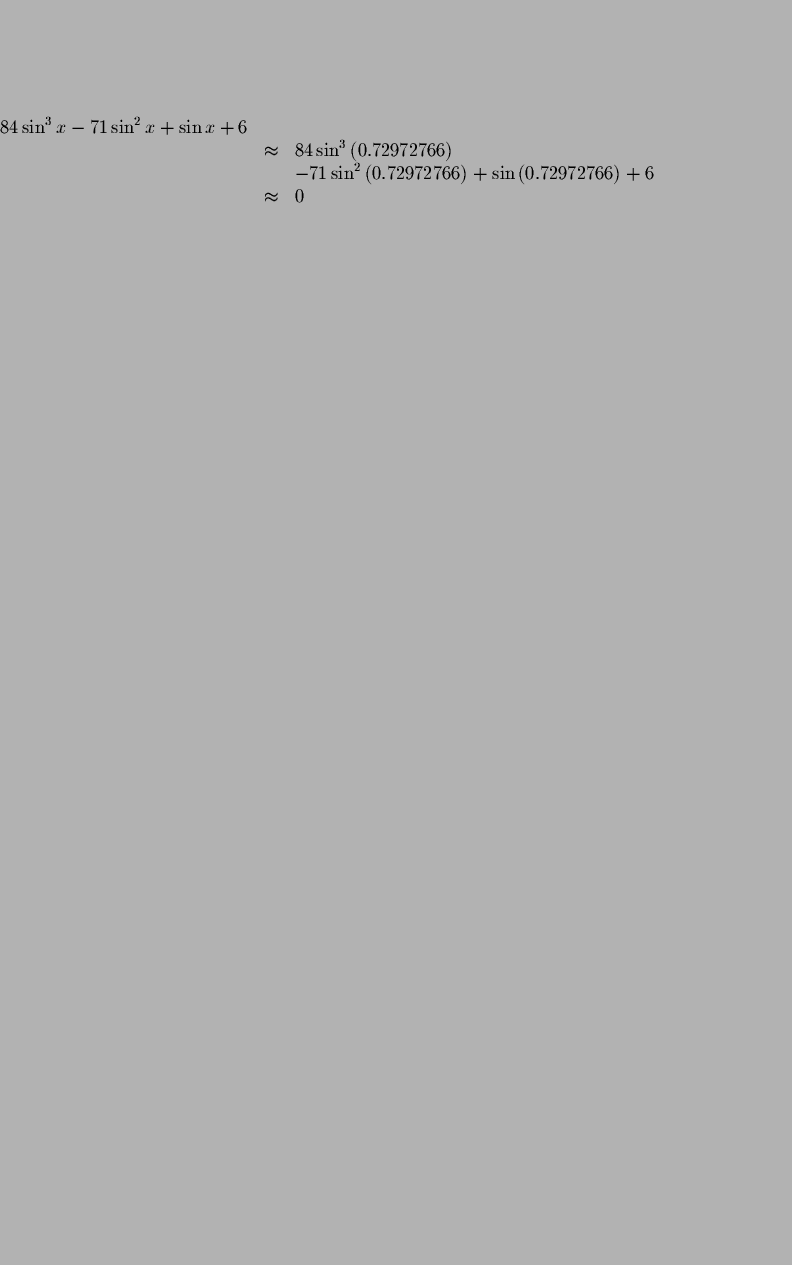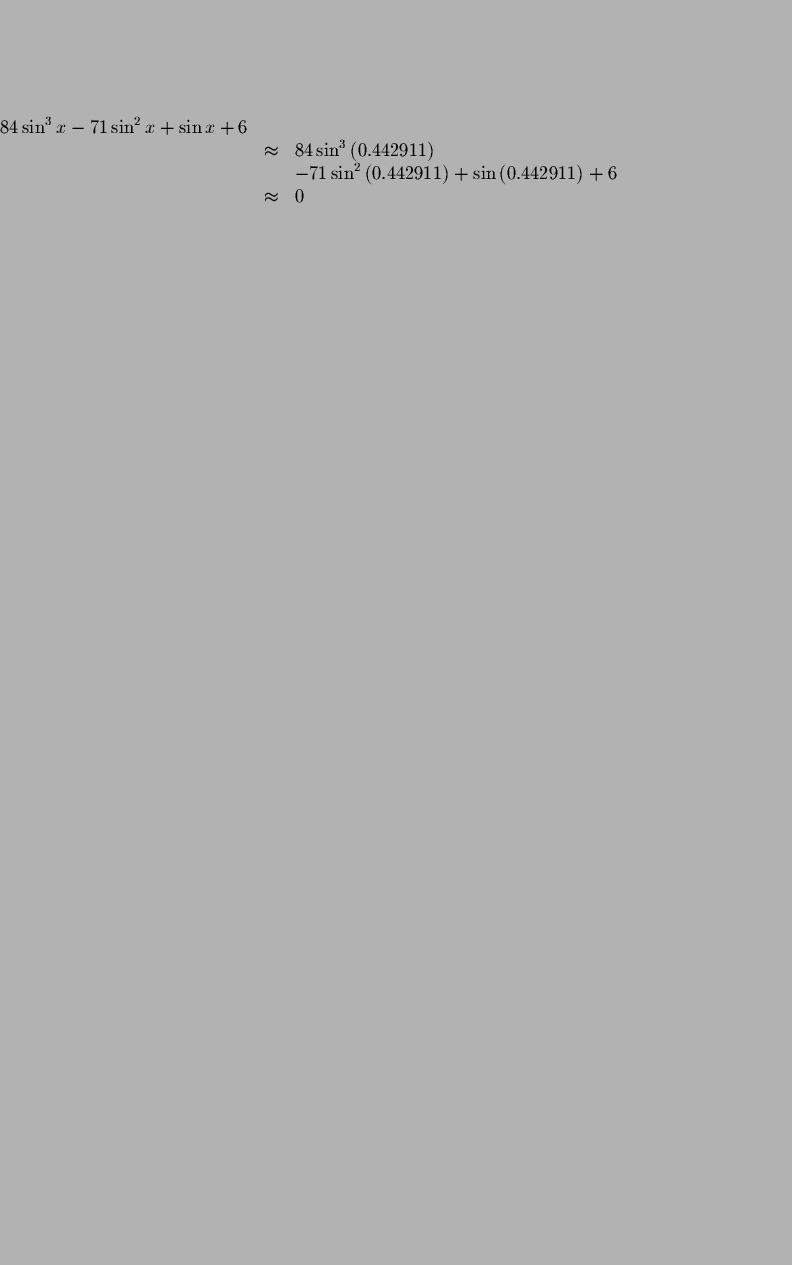 SOLVING TRIGONOMETRIC EQUATIONS
SOLVING TRIGONOMETRIC EQUATIONS SOLVING TRIGONOMETRIC EQUATIONS
SOLVING TRIGONOMETRIC EQUATIONS
Note: If you would like a review of trigonometry, click on trigonometry.
Problem 9.12a: Solve for x in the equation
Answer: The exact answers are

where n is an integer.
The approximate values of these solutions are

Solution:
There are an infinite number of solutions to this problem. Let's simplify
the problem by rewriting it in an equivalent factored form.

The only way the product equals zero is if at least one of the factors
equals zero. Therefore,
![]() if
if
![]() ,
,
![]() or
or
![]()

How do we isolate the x in each of these equations? We could take the inverse (arcsine) of both sides of the equation. However, the sine function is not a one-to-one function.
Let's restrict the domain so the function is one-to-one on the restricted
domain while preserving the original range. The sine function is one-to-one
on the interval
![$\left[ -\displaystyle \displaystyle \frac{\pi }{2},\displaystyle \displaystyle \frac{\pi }{2}\right] .$](img11.gif) If we
restrict the domain of the sine function to that interval , we can take the
arcsine of both sides of each equation.
If we
restrict the domain of the sine function to that interval , we can take the
arcsine of both sides of each equation.

We know that
![]() Therefore, if .
Therefore, if .

Since the period of ![]() equals
equals ![]() ,
these solutions will repeat
every
,
these solutions will repeat
every ![]() units. The exact solutions are
units. The exact solutions are

where n is an integer.
The approximate values of these solutions are

where n is an integer.
You can check each solution algebraically by substituting each solution in the original equation. If, after the substitution, the left side of the original equation equals the right side of the original equation, the solution is valid.
You can also check the solutions graphically by graphing the function formed by subtracting the right side of the original equation from the left side of the original equation. The solutions of the original equation are the x-intercepts of this graph.
Algebraic Check:
Check solution

Left Side:

Right Side: ![]()
Since the left side of the original equation equals the right side of the original equation when you substitute 0.72972766 for x, then 0.72972766is a solution.
Check solution

Left Side:

Right Side: ![]()
Since the left side of the original equation equals the right side of the original equation when you substitute 2.411865 for x, then 2.411865 is a solution.
Check solution

Left Side:

Right Side: ![]()
Since the left side of the original equation equals the right side of the original equation when you substitute 0.442911 for x, then 0.442911 is a solution.
Check solution

Left Side:

Right Side: ![]()
Since the left side of the original equation equals the right side of the original equation when you substitute 2.411865 for x, then 2.411865 is a solution.
Check solution

Left Side:

Right Side: ![]()
Since the left side of the original equation equals the right side of the original equation when you substitute 3.394273 for x, then 0.72972766 is a solution.
Check solution

Left Side:

Right Side: ![]()
Since the left side of the original equation equals the right side of the original equation when you substitute 2.69868 for x, then 2.69868 is a solution.
We have just verified algebraically that the exact solutions are
 and these solutions repeat every
and these solutions repeat every ![]() units.
units.
The approximate values of these solutions are
![]()
![]() and <tex2htmlcommentmark>
2.69868 and these solutions repeat every
and <tex2htmlcommentmark>
2.69868 and these solutions repeat every
![]() units.
units.
Graphical Check:
Graph the function
![]() ,
formed by
subtracting the right side of the original equation from the left side of
the original equation. The x-intercepts are the real solutions.
,
formed by
subtracting the right side of the original equation from the left side of
the original equation. The x-intercepts are the real solutions.
. Note that the graph crosses the x-axis many times indicating many solutions. Let's check a few of these x-intercepts against the solutions we derived.
Verify the graph crosses the x-axis at
-0.252680. Since the period is
![]() ,
you can verify that the graph also crosses the
x-axis again at
-0.252680+6.2831853=6.0305053 and at
,
you can verify that the graph also crosses the
x-axis again at
-0.252680+6.2831853=6.0305053 and at
![]() ,
etc.
,
etc.
Verify the graph crosses the x-axis at 0.442911. Since the period is
![]() ,
you can verify that the graph also crosses the x-axis
again at
0.442911+6.2831853=6.7260963 and at
,
you can verify that the graph also crosses the x-axis
again at
0.442911+6.2831853=6.7260963 and at
![]() 13.009282, etc.
13.009282, etc.
Verify the graph crosses the x-axis at 0.729728. Since the period is
![]() ,
you can verify that the graph also crosses the x-axis
again at
0.729728+6.2831853=7.0129133 and at
,
you can verify that the graph also crosses the x-axis
again at
0.729728+6.2831853=7.0129133 and at
![]() etc.
etc.
Verify the graph crosses the x-axis at 2.411865. Since the period is
![]() ,
you can verify that the graph also crosses the x-axis
again at
2.411865+6.2831853=8.6950503 and at
,
you can verify that the graph also crosses the x-axis
again at
2.411865+6.2831853=8.6950503 and at
![]() ,
etc.
,
etc.
Verify the graph crosses the x-axis at 2.69868. Since the period is
![]() ,
you can verify that the graph also crosses the x-axis
again at
2.69868+6.2831853=8.9818653 and at
,
you can verify that the graph also crosses the x-axis
again at
2.69868+6.2831853=8.9818653 and at
![]() etc.
etc.
Verify the graph crosses the x-axis at 3.394273. Since the period is
![]() ,
you can verify that the graph also crosses the x-axis
again at
3.394273+6.2831853=9.6774583 and at
,
you can verify that the graph also crosses the x-axis
again at
3.394273+6.2831853=9.6774583 and at
![]() etc.
etc.
Note: If the problem were to find the solutions in the interval
![]() ,
then you choose those solutions from the set of infinite
solutions that belong to the set
,
then you choose those solutions from the set of infinite
solutions that belong to the set
![]()
![]() and
and
![]()
If you would like to review the solution of another problem, click on
solution.
If you would like to go back to the equation table of contents, click on Contents.

